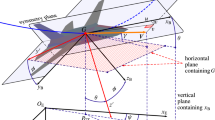Abstract
The ability of neural networks to learn from repeated exposure to system characteristics has made them a popular choice for many applications in linear and non-linear control. In this paper, the capabilities of neural networks in detecting and accommodating control surface failures for a modified F/A-18 ‘super-manoeuverable’ fighter aircraft are examined. To detect and accommodate a failure in the thrust vectoring vane during a pitch manoeuvre, a hierarchical neuro-controller is designed using thrust vectoring, symmetric leading edge flap and the throttle. This neuro- controller is then used as the fault accommodating neuro- controller. A separate neural network is trained to detect failures in the thrust vectoring vane. The performance of the controller and fault-detection networks are verified using a numerical simulation of a longitudinal model of the aircraft.
Similar content being viewed by others
References
Gertler JJ. Survey of model-based failure detection and isolation in complex plants. IEEE Contr Syst Mag 1988; December
Stengel RF. Intelligent failure-tolerant control. IEEE Cont Syst Mag 1991; June
Rauch EH, Kline-Schoder RJ, Adams JC, Youssef HM. Fault detection, isolation, and reconfiguration for aircraft using neural network. In: Proceedings 1993 AIAA Guidance, Navigation, and Control Conference, pp. 1527–1537
Narendra KS, Parathasarsthy K. Identification and control of dynamic systems using neural networks. IEEE Trans Neural Net 1990; March
Smith JC, Walters RV, Jex HR, Alphonso BL. Application of an adaptive clustering network to light control of a fighter aircraft. National Information Technical Service #92-18842, 19 December 1991
Bishop T, Grennwood D, Shew K, Stevenson F. Space shuttle main engine fault detection using neural networks. In: Proceedings of the Second Joint Technology Workshop on Neural Networks and Fuzzy Logic, 1991, NITS #N91-20816.
Werbos PJ. Back-propagation through time: what it does and how to do it. In: Proceedings IEEE 1990; 78: 1550–1560
Werbos PJ. A menu of designs for reinforcement learning over time. In: Neural Networks for Control, MIT Press, Cambridge, MA, 1990, p. 67
Sutton RS. Learning to predict the method of temporal differences. Machine Learning 1988; 3:9–44
Valavani L, Voulgaris P. High performance linear-quadratic and hi-infinity designs for a ‘super-manoeuverable’ aircraft. J Guidance, Contr Dynamics 1991;14(1) 157–165
KrishnaKumar K. Optimization of the neural net connectivity pattern using a back-propagation algorithm. J Neurocomput 1993; 5: 1–14
Author information
Authors and Affiliations
Corresponding author
Rights and permissions
About this article
Cite this article
KrishnaKumar, K., Lattus, R. Control surface failure detection and accommodation using neuro-controllers. Neural Comput & Applic 2, 120–128 (1994). https://doi.org/10.1007/BF01415007
Received:
Issue Date:
DOI: https://doi.org/10.1007/BF01415007




